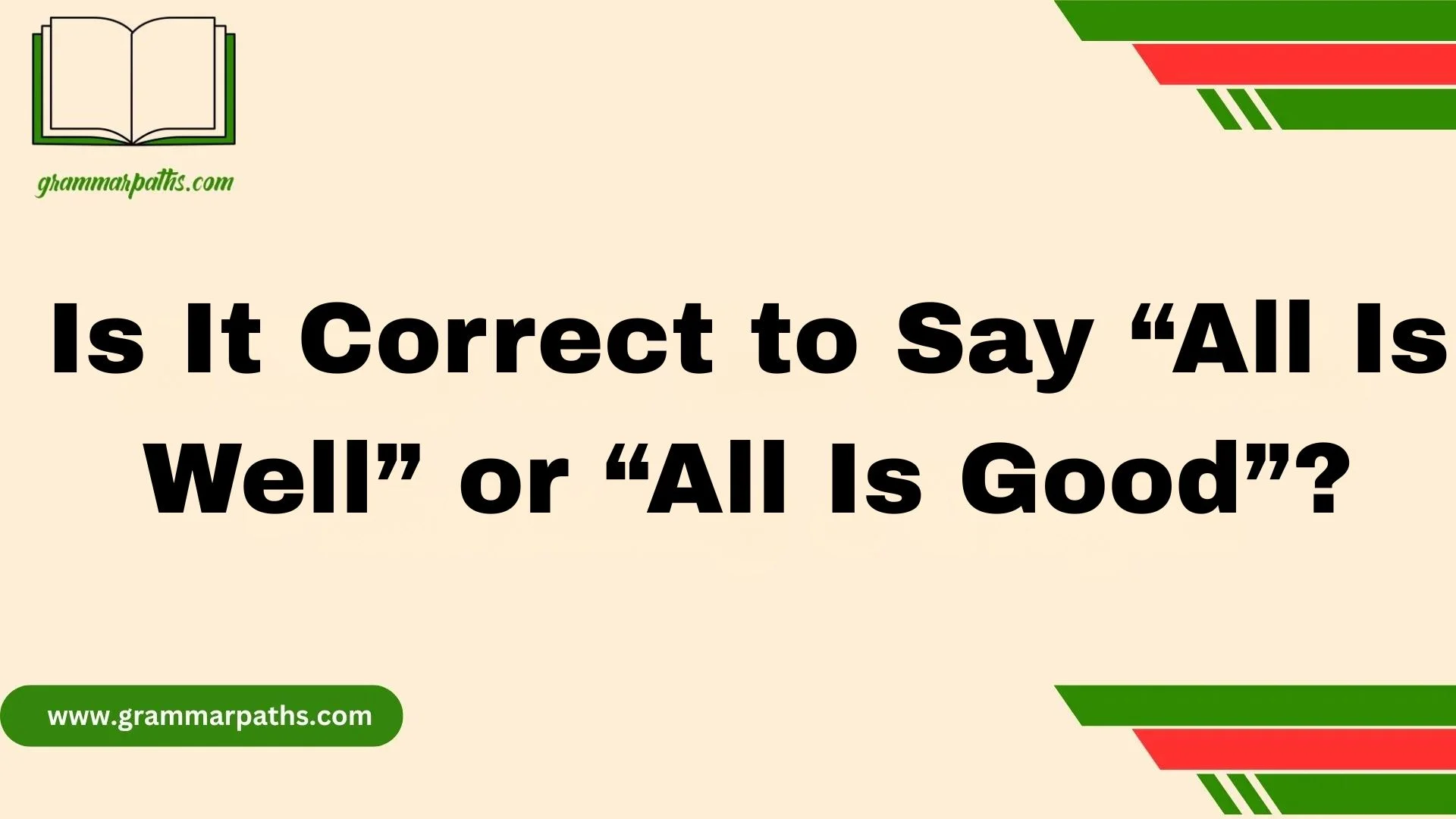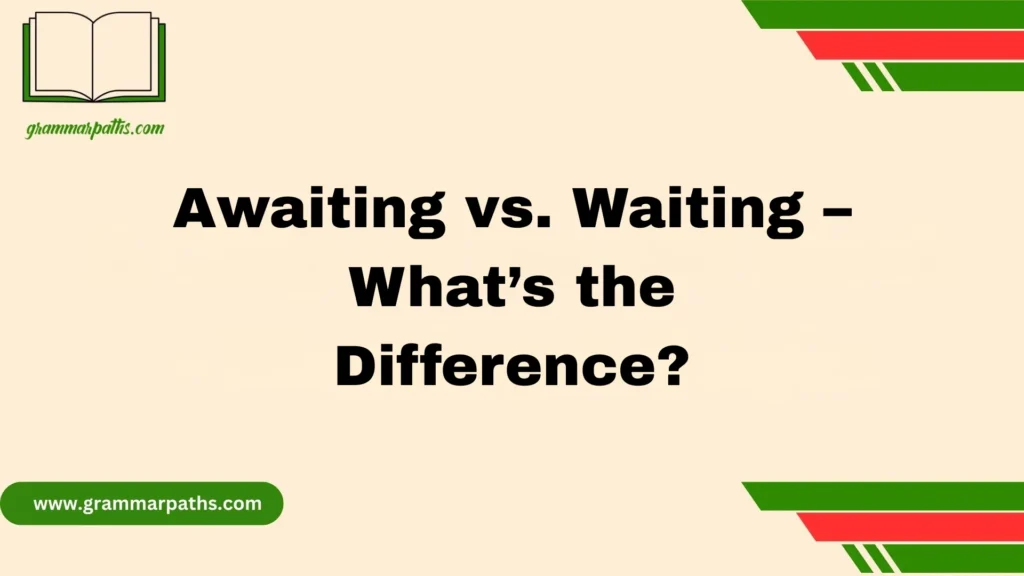When someone casually asks whether they should say “all is well” or “all is good,” it can feel more complicated than it seems. From my experience as a language coach and writer, these choices aren’t just about being grammatically correct. They involve navigating the many layers of English grammar, shifting usage, and personal preferences that are evolving across cultures. I once worked with a client writing a heartfelt letter to a friend, and they asked the same thing. We took a thoughtful walk through these expressions, looking not just at rules, but at tone and feeling. “All is well” connects with traditional, poetic roots, while “all is good” carries a relaxed, modern, conversational vibe.
The phrase you choose depends on what you want to express, when and where you are saying it. “All is well” reflects calm and order, making it perfect for formal emails or deeper moments. On the other hand, “all is good” works better when chatting with friends or reacting to casual news. It’s helpful to learn these differences, not only to get the grammar right, but to capture the subtle meaning behind your words. Think of this as a friendly guide to help you know which to pick, based on what feels natural. Everything tells a story of grammatical structure, cultural change, and personal expression, knowing the choice allows you to use each with confidence.
Historical and Traditional Perspective
The Origins of “All Is Well”
The phrase “all is well” has a long-standing history in English. Its roots can be traced back to early literary works, often appearing in letters, novels, and even religious texts. It has traditionally conveyed a sense of calm assurance or resolution.
For example, in classic literature, you might find sentences like:“Fear not, all is well, for the matter has been resolved.”
Here, the phrase signals formal assurance, often in situations requiring a polished tone. Its longevity shows that it carries a weight of tradition, reliability, and propriety.
Formality and Context
“All is well” tends to appear in:
- Formal letters and emails
- Professional settings like speeches or official statements
- Literature and historical writings
It’s considered timeless, professional, and universally understood. Using it in a casual text message may sound slightly old-fashioned, but it still conveys correctness.
Grammar Deep Dive: Well vs. Good
Understanding the Parts of Speech
To grasp why “all is well” is technically more accurate than “all is good”, we need to examine grammar basics.
- Well – Primarily an adverb, but can function as an adjective when referring to health. Example:
- Adverb: “She sings well.”
- Adjective: “He is well after the surgery.”
- Good – An adjective that describes nouns. Example:
- “This is a good book.”
When we say “all is well”, we are using well as an adjective meaning “in a satisfactory state” or “free from problems.”
Why Grammar Matters
Using “all is good” technically treats good as an adjective modifying all, which is abstract. While it’s widely accepted in casual speech, grammarians argue it’s less precise because well communicates state or condition.
Example:
| Phrase | Correctness | Context | Nuance |
| All is well | ✅ Grammatically correct | Formal & casual | Shows proper state, health, or situation |
| All is good | ⚠️ Informal | Casual & modern | Friendly, relaxed tone, but not strictly formal |
Common Pitfalls
- Confusing adverbs and adjectives can lead to sentences like “He did good”, which is common in informal speech but should be “He did well” in formal contexts.
- Remember: well = state/condition, good = quality.
Modern Usage: “All Is Good”
Emergence in American English
Over the past few decades, “all is good” has gained traction, especially in American slang and casual communication. Social media, text messaging, and pop culture have normalized this phrase.
- Example in casual conversation:
“Don’t worry about the delay, all is good.”
It’s friendly, laid-back, and conveys reassurance without formality.
Informality vs. Professionalism
While “all is good” is acceptable among friends or colleagues in informal settings, using it in a business report, formal email, or public speech may appear careless.
- When it works:
- Text messages
- Social media replies
- Casual workplace chats
- When it doesn’t:
- Business correspondence
- Academic writing
- Legal or official communication
Tip: Consider your audience before choosing the phrase. Tone and context always matter more than strict grammar in modern communication.
Contextual Analysis: Choosing the Right Phrase
Interpersonal Communication
In everyday conversations, either phrase can work, but they carry subtle differences.
| Scenario | Recommended Phrase | Why |
| Chatting with friends | All is good | Relaxed, casual, approachable |
| Texting family | All is well / All is good | Both work; “well” is slightly more formal |
| Workplace chat | All is good | Friendly tone accepted among colleagues |
| Formal email | All is well | Maintains professionalism and clarity |
Professional and Formal Settings
For official letters, reports, or academic writing, “all is well” maintains credibility and grammatical correctness.
Example:
“After reviewing the quarterly report, I can confirm that all is well with our financial projections.”
Using “all is good” here might undermine authority or precision.
Cultural Perception
Different English-speaking regions perceive these phrases differently:
- United States: “All is good” is common, casual, and widely understood.
- United Kingdom & Commonwealth countries: “All is well” is more prevalent in formal settings; “all is good” may sound informal or slangy.
Understanding these nuances ensures your message is received as intended.
Practical Examples and Comparisons
Side-by-side comparisons help clarify the difference:
| Context | All is Well | All is Good |
| Friend asks about your day | ✔ “All is well, thanks!” | ✔ “All is good, thanks!” |
| Workplace update | ✔ “All is well with the project.” | ⚠️ “All is good with the project.” |
| Formal announcement | ✔ “We are pleased to report all is well.” | ❌ Less formal, may appear casual |
These examples show that while both phrases convey reassurance, formality, tone, and context determine which to choose.
Alternative Phrases and Synonyms
If you want to vary your language or sound more natural, there are many alternative expressions:
- Everything’s fine – Neutral, versatile
- Everything’s okay – Casual, informal
- All’s well here – Slightly formal, friendly
- No issues / No problems – Professional, concise
| Phrase | Tone | Context |
| Everything’s fine | Neutral | Everyday conversation, emails |
| Everything’s okay | Casual | Friends, social media |
| All’s well here | Friendly/formal | Letters, professional chats |
| No issues | Professional | Business emails, status reports |
Choosing an alternative can make your writing sound natural, fluent, and context-appropriate.
Summary and Practical Takeaways
- “All is well” = formal, correct, traditional; suitable for professional, academic, or official communication.
- “All is good” = informal, casual, widely used in modern American English; fits friendly or relaxed settings.
- Consider tone, audience, and context before choosing.
- Use alternative phrases when you want flexibility or variety in your writing.
Quick Tips:
- When writing professionally, stick with all is well.
- When chatting casually or using social media, all is good works perfectly.
- Remember the grammar rule: well = state/condition, good = quality.
Conclusion
Understanding whether to say “All is well” or “All is good” comes down to context, tone, and personal preference. All is well fits formal, calm, and structured situations, while all is good leans toward a relaxed, conversational, and friendly vibe. By recognizing the grammar, usage, and cultural nuances behind these phrases, you can confidently choose the expression that best reflects your intent, moment, and audience. Being aware of these differences also helps you capture the subtle meaning and express yourself naturally in both formal and casual settings.
FAQs
Q1: Is “All is well” more formal than “All is good”?
Yes, all is well is formal, structured, and often used in emails, letters, or official communication, while all is good is casual, friendly, and suitable for conversations with friends.
Q2: Can I use “All is good” in professional writing?
It’s generally better to use all is well in formal contexts. All is good works if you want a relaxed, conversational tone, but may not fit formal or official communication.
Q3: Do both phrases mean the same thing?
Both convey that things are okay, but the tone, formality, and cultural context differ. Choosing the right one depends on who you are speaking to and the situation.
Q4: How do I decide which phrase to use?
Consider the audience, the formality of the setting, and the vibe you want to express. All is well suits calm, formal, or serious moments, while all is good suits casual, friendly, or informal moments.

Grace Marie is the dedicated writer behind GrammarPaths.com, where she shares her passion for English grammar, idioms, and writing mastery. With a strong background in language studies and years of experience helping learners improve their communication skills, Grace creates clear, practical, and engaging content that makes English easy to understand.










